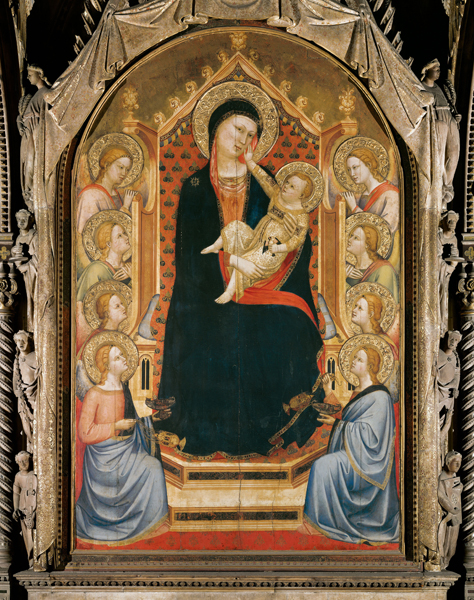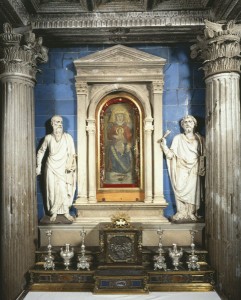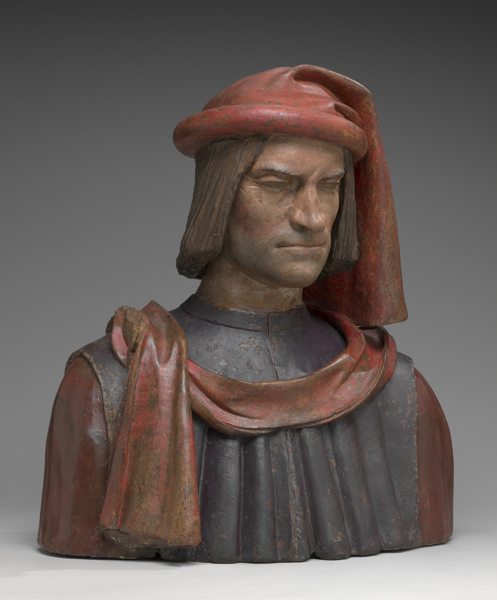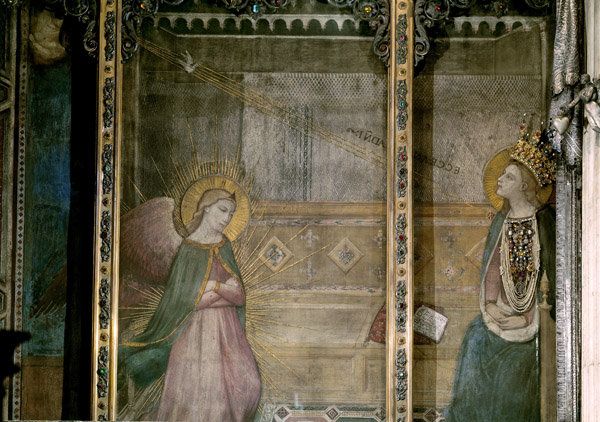
Bernardo Daddi
Madonna delle Grazie, 1347
Altarpiece painted panel
Orsanmichele, Florence
Scala/Art Resource, NY
Like processions, performances of sacred plays, and the sermons of street preachers, images were a part of the spectacle of life in a Renaissance city. In Florence three miracle-working images of the Virgin were the particular focus of public devotion; they played a role in shaping and projecting the city’s identity. Citizens of all ranks participated in their rituals, most of which took place in the open air. Confraternities took them under their care and sang hymns to them; jealousies were sometimes aroused. Individuals, even members of elite and humanist circles, paid private visits to the images to pray and invoke their help.
One of these miracle-working Madonnas was a fresco of the Virgin painted in the loggia at Orsanmichele. She is said to have begun performing miracles in 1292, soon after a confraternity was founded to sing lauds in her praise. Following a fire only twelve years later, a new image replaced the

Florentine, 11th century
Tempietto della Madonna, “The Impruneta”
Altarpiece painting on panel
S. Maria, Impruneta, Italy
Scala/Art Resource, NY
original. In 1347 yet a third image was commissioned, from artist Bernardo Daddi, and the second—which perhaps had begun to look a bit old-fashioned—was moved to a side aisle. Daddi’s Virgin took up the miracle-working role of its predecessors. (Whether the second Madonna continued to produce miracles in its new location is not known.)
The powers of another miracle-working Virgin, a panel that resided in the small town of Impruneta six miles outside the city, were activated only when she was brought in procession to Florence. The panel, known as the Impruneta, was called on to bring rain (or stop it), but she protected the city in many other ways as well, such as saving it from sacking armies and inspiring wisdom in political decisions. Contemporaries treated her like a real person who not only heard their prayers but also appreciated the gifts they made her (see “Excerpts from the diary of Luca Landucci about the Impruneta”).
The Annunciation
The rich tabernacle framing the Annunziata was commissioned in 1448 by the Medici family. Small copies could be seen set into walls along the streets of Florence, and the composition became one of the two models most often used in the city for depicting the Annunciation (the other was a mosaic in the baptistery from the late thirteenth century). When important foreign guests visited the city, they were taken first to see the Annunziata, even before meeting with officials. Rich and poor alike made votive dedications to the image. Some of these were in the form of simple stamped reliefs; others were paintings or wax effigies. Although the ex-votos had been culled periodically, some 3,600 were extant before they were removed from Santissima Annunziata in the 1630s over strong popular protest (see “A wax ex-voto for the Virgin of Santa Maria in Carceri”).
Yet another miraculous image was a Virgin of the Annunciation whose face was said to have been painted by angels. Although the fresco in Santissima Annunziata seems to date from the mid-fourteenth century, a history of the Servite order put its origin in 1252, when one Bartolommeo struggled to complete his painting on the walls of the Servite oratorio. A description of his efforts reminds us that painting was itself a devotional act:
At the time he wished to paint the image of the Virgin, he worked very hard, with fasting and prayers, and he passed sleepless nights . . . lying on the bare ground. He entreated the Virgin repeatedly that he might be able to design the true likeness of her face through his very great love. . . . His prayers were heard and returning to his work in the morning, he discovered the [Virgin’s] body completed with the head, and it seemed without a doubt that this was because it had been made by the hand of an angel.12
Florentine Franco Sacchetti (1332–1400) noted with some amusement a certain competition among the city’s miracle-working images: “There was a time when each person ran to Santa Maria da Cigoli; then to Santa Maria della Selva; then the fame increased of Santa Maria in Impruneta, then to Fiesole, to Santa Maria Primerana; and then to Our Lady of Orsanmichele; then they abandoned all of these and every person has converged on the Annunziata of the Servites where, in one manner or another, there have been placed and hung so many [votive] images that if the wall hadn’t been reinforced with chains a little while ago, they would have been in danger of coming down together with the roof.”13
Lorenzo de’ Medici

Florentine 15th or 16th century, probably after a model by Andrea del Verrocchio and Orsino Benintendi
Lorenzo de’ Medici, 1478/1521
Painted terra-cotta, 65.8 x 59.1 x 32.7 cm (25 7/8 x 23 1/4 x 12 7/8 in.)
National Gallery of Art, Washington, DC, Samuel H. Kress Collection
Image courtesy of the Board of Trustees, National Gallery of Art
In 1478, Lorenzo de’ Medici survived an assassination attempt that claimed the life of his younger brother. As thanksgiving for his deliverance—and to press home his political survival—he had wax effigies placed in several churches, including Santissima Annunziata. One of them was dressed in the actual garments Lorenzo had worn on the day of his attack. This terra-cotta bust may reproduce one of those wax votives.
